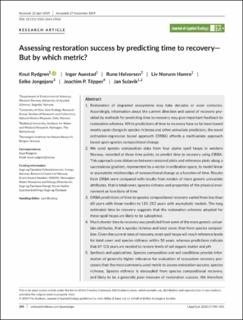| dc.contributor.author | Rydgren, Knut | |
| dc.contributor.author | Auestad, Inger | |
| dc.contributor.author | Halvorsen, Rune | |
| dc.contributor.author | Hamre, Liv Norunn | |
| dc.contributor.author | Jongejans, Eelke | |
| dc.contributor.author | Töpper, Joachim Paul | |
| dc.contributor.author | Sulavik, Jan | |
| dc.coverage.spatial | Norway | en_US |
| dc.date.accessioned | 2020-03-13T08:48:03Z | |
| dc.date.available | 2020-03-13T08:48:03Z | |
| dc.date.created | 2019-12-11T12:11:05Z | |
| dc.date.issued | 2019 | |
| dc.identifier.citation | Rydgren, K., Auestad, I., Halvorsen, R., Hamre, L. N., Jongejans, E., Töpper, J. P., … Brudvig, L. (2019). Assessing restoration success by predicting time to recovery—But by which metric? Journal of Applied Ecology, 57(2), 390-401. | en_US |
| dc.identifier.issn | 0021-8901 | |
| dc.identifier.uri | https://hdl.handle.net/11250/2646658 | |
| dc.description.abstract | 1. Restoration of degraded ecosystems may take decades or even centuries. Accordingly, information about the current direction and speed of recovery provided by methods for predicting time to recovery may give important feedback to restoration schemes. While predictions of time to recovery have so far been based mostly upon change in species richness and other univariate predictors, the novel ordination-regression based approach (ORBA) affords a multivariate approach based upon species compositional change. 2. We used species composition data from four alpine spoil heaps in western Norway, recorded at three time points, to predict time to recovery using ORBA. This approach uses distances between restored plots and reference plots along a successional gradient, represented by a vector in ordination space, to model linear or asymptotic relationships of compositional change as a function of time. Results from ORBA were compared with results from models of more generic univariate attributes, that is total cover, species richness and properties of the physical environment as functions of time. 3. ORBA predictions of time to species compositional recovery varied from less than 60 years with linear models to 115–212 years with asymptotic models. The long estimated time to recovery suggests that the restoration schemes adopted for these spoil heaps are likely to be suboptimal. 4. Much shorter time to recovery was predicted from some of the more generic univariate attributes, that is species richness and total cover, than from species composition. Given the current rates of recovery, most spoil heaps will reach reference levels for total cover and species richness within 50 years, whereas predictions indicate that 67–111 years are needed to restore levels of soil organic matter and pH. 5. Synthesis and applications. Species composition and soil conditions provide information of generally higher relevance for evaluation of ecosystem recovery processes than the most commonly used metric to assess restoration success, species richness. Species richness is decoupled from species compositional recovery, and likely to be a generally poor measure of restoration success. We therefore encourage further improvement of methods like the ordination-regression based approach that use species compositional data to predict time to recovery. | en_US |
| dc.language.iso | eng | en_US |
| dc.publisher | Wiley | en_US |
| dc.rights | Navngivelse 4.0 Internasjonal | * |
| dc.rights.uri | http://creativecommons.org/licenses/by/4.0/deed.no | * |
| dc.subject | ORBA | en_US |
| dc.subject | Ordination-Regression Based Approach | en_US |
| dc.subject | restoration ecology | en_US |
| dc.subject | soil conditions | en_US |
| dc.subject | species composition | en_US |
| dc.subject | species richness | en_US |
| dc.subject | spoil heaps | en_US |
| dc.subject | time to recovery | en_US |
| dc.title | Assessing restoration success by predicting time to recovery- But by which metric? | en_US |
| dc.type | Peer reviewed | en_US |
| dc.type | Journal article | en_US |
| dc.description.version | publishedVersion | en_US |
| dc.subject.nsi | VDP::Basale biofag: 470 | en_US |
| dc.subject.nsi | VDP::Basic biosciences: 470 | en_US |
| dc.source.pagenumber | 390-401 | en_US |
| dc.source.volume | 57 | en_US |
| dc.source.journal | Journal of Applied Ecology | en_US |
| dc.source.issue | 2 | en_US |
| dc.identifier.doi | 10.1111/1365-2664.13526 | |
| dc.identifier.cristin | 1759251 | |
| dc.relation.project | Andre: Energy Norway | en_US |
| dc.relation.project | Andre: Norwegian Water Resources and Energy Directorate | en_US |
| dc.relation.project | Andre: Norsk Hydro | en_US |
| dc.relation.project | Andre: Sogn og Fjordane Energi | en_US |
| dc.relation.project | Andre: Sparebankstiftinga Sogn og Fjordane | en_US |
| dc.relation.project | Andre: Sogn og Fjordane Fylkeskommune; | en_US |
| dc.relation.project | Andre: NORSK HYDRO | en_US |
| dc.relation.project | Andre: ENERGY NORWAY | en_US |
| dc.relation.project | Andre: NORWEGIAN WATER RESOURCES AND ENERGY DIRECTORATE | en_US |
| dc.relation.project | Andre: SOGN OG FJORDANE ENERGI | en_US |
| dc.relation.project | Andre: SPAREBANKSTIFTINGA SOGN OG FJORDANE | en_US |
| dc.relation.project | Andre: SOGN OG FJORDANE FYLKESKOMMUNE; | en_US |
| cristin.ispublished | true | |
| cristin.fulltext | original | |
| cristin.qualitycode | 2 | |

